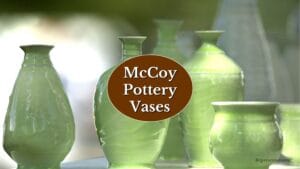If you found an old pottery vase in your attic or living room that says “McCoy” on the bottom, keep it safe! It could be a rare McCoy vase worth hundreds or even thousands!
McCoy pottery may last for a long time, and its legacy still continues, with pieces like vases and platters being the most collectible items. But many still struggle to spot real pieces from dupes and understand their real worth!
In this list, I’m going to show you some of the 14 rarest McCoy vases worth big money, plus exactly how you can spot McCoy vases and what makes collectors go crazy over them!
Why Is McCoy Pottery So Special?
The roots of McCoy pottery were laid when Nelson McCoy Sr. decided to start a pottery company in Roseville, Ohio, in 1910. It started as “Nelson McCoy Sanitary and Stoneware Company,” making practical items like crocks, mixing bowls, and other utility stuff.
Things changed in 1933, when people began asking for decorative pottery instead of practical stoneware.
McCoy used this opportunity, dropped “Sanitary” from their name, and changed it to “Nelson McCoy Pottery Co.,” which made stuff like vases, planters, and jars.
The McCoy family ran things for 57 years before they sold to Mount Clemens Pottery in 1967, which then flipped it to Lancaster Colony Corporation in 1974.
Finally, Designer Accents bought it in 1985, but by 1990, all companies were shut, and McCoy Pottery vanished. But the art never died. After decades, McCoy pottery made a comeback, this time as a collectible because people treasured the early ceramics.
14 Rare McCoy Pottery Vases You Need to Find Now!
Out of all utility and decor pieces, McCoy’s vases are easily the most collectible pieces. Below are some of the rarest vases that can easily sell for hundreds!
1. McCoy Pink Poppy Planter Vase

This beautiful McCoy planter from 1955 is shaped and painted to look like a three-dimensional blooming pink poppy with green leafy details. The fine, hand-painted details and bright glaze on this vase make it one of the most popular McCoy pieces.
Depending on condition and color variations, this vase can fetch $100-$450 today.
2. Art Deco Ledge Vase
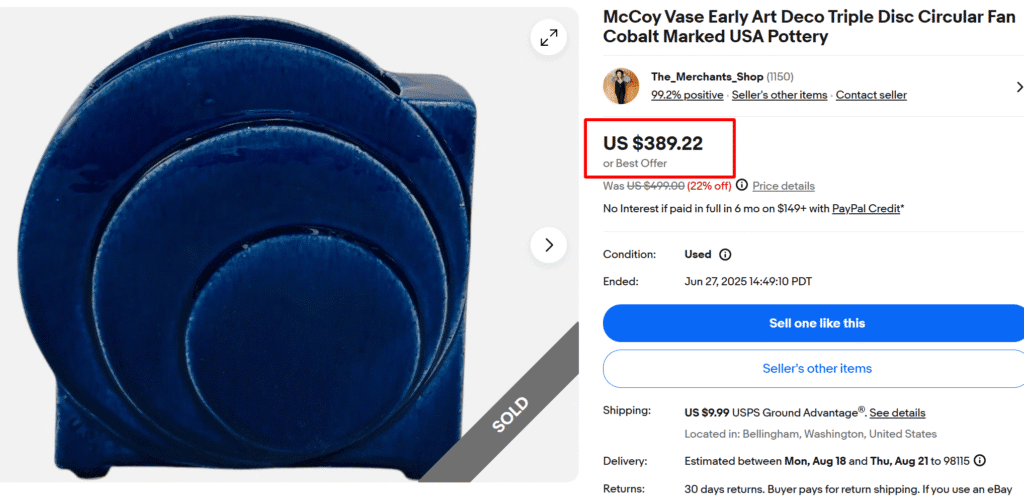
This is a unique Art Deco “Triple Disc” vase featuring bold circular fan patterns in bright cobalt blue glaze. It’s marked “USA” on the bottom and has McCoy’s distinctive 1930s shiny look.
This vase is available in other pastel colors, but the cobalt blue one is easily one of the most sought-after; no wonder it sold for almost $390 on eBay!
3. Brush McCoy Matte Green Two Handle Vase
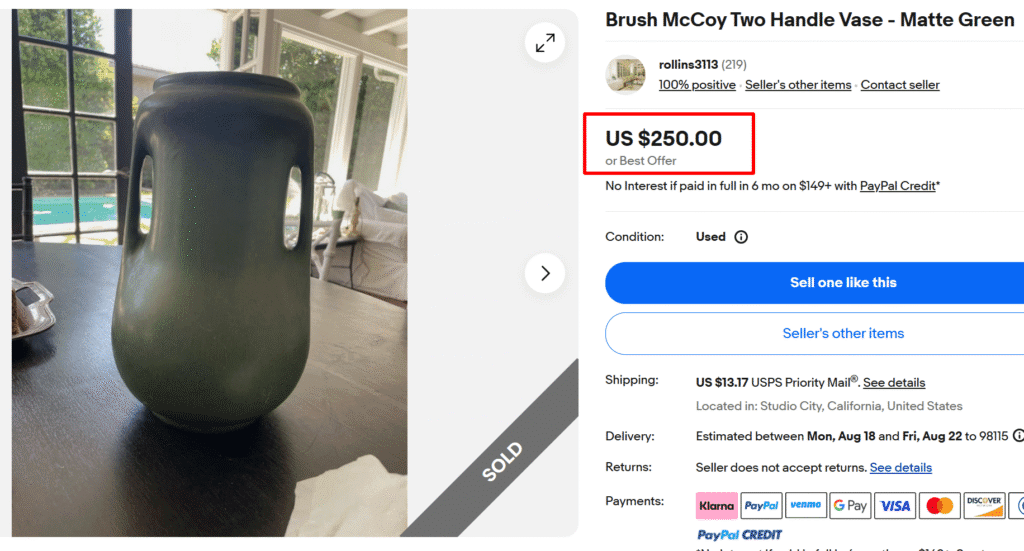
This is actually a Brush McCoy piece, which predates (1911-1923) the Nelson McCoy company and is even more collectible. It has the signature matte green finish the brand was known for and dual handles with a gently rounded shape.
Genuine pieces with authentic wear and light crazing, like this piece, are more desirable among collectors; this piece sold for $250!
4. McCoy Pottery Ribbon Strap Vase
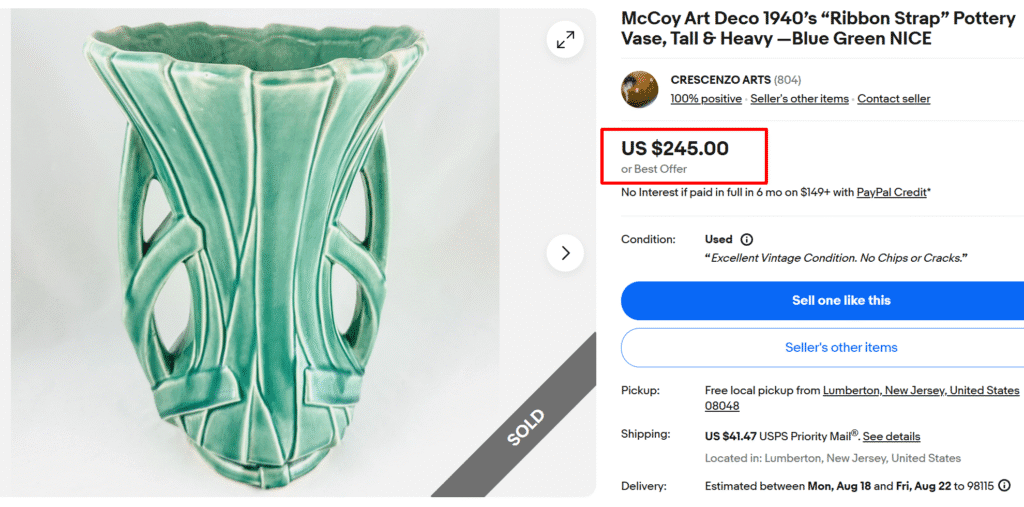
This dramatic, heavy McCoy vase from the 1940s shows the “Ribbon Strap” Art Deco pattern in a soothing blue-green glaze. You can spot it with the unique raised strapping details and flared opening with two handles.
Vases with this pattern and unique colors, like this blue-green glaze, can be highly valuable, around $150 to $350, especially in excellent condition. Make sure to check for the “McCoy” marking at the bottom to verify the piece.
5. White Calla Lily Vase
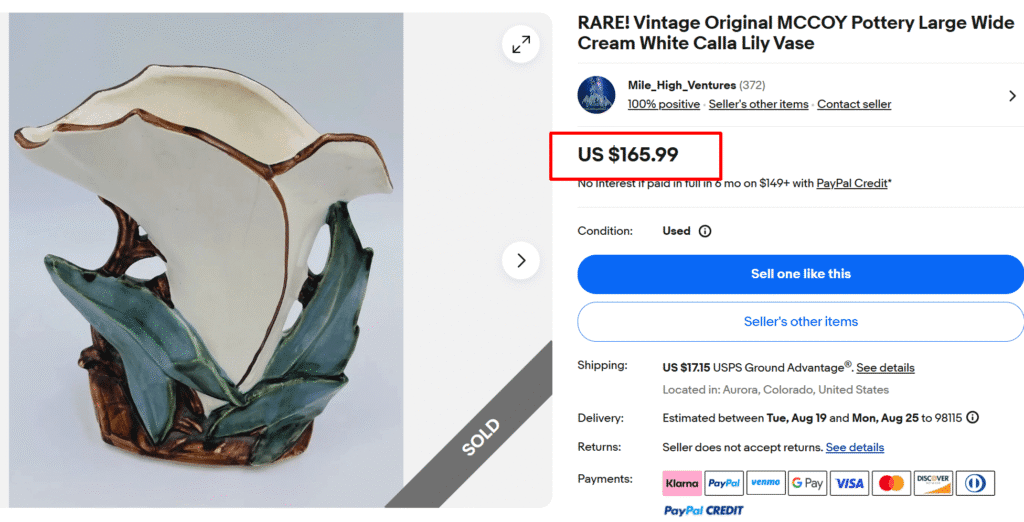
This McCoy Calla Lily vase is a true example of the company’s mastery of floral designs. You can spot it by a large, hand-painted, lifelike, creamy white calla lily in full bloom with green leaves and brown roots.
This large piece is a part of McCoy’s popular floral line from the mid-20th century. There’s another version of this vase with three lilies, but single ones are worth more, like this one sold for over $165. Also, you may find these with yellow and pink lilies.
6. Nelson McCoy Butterfly Vase
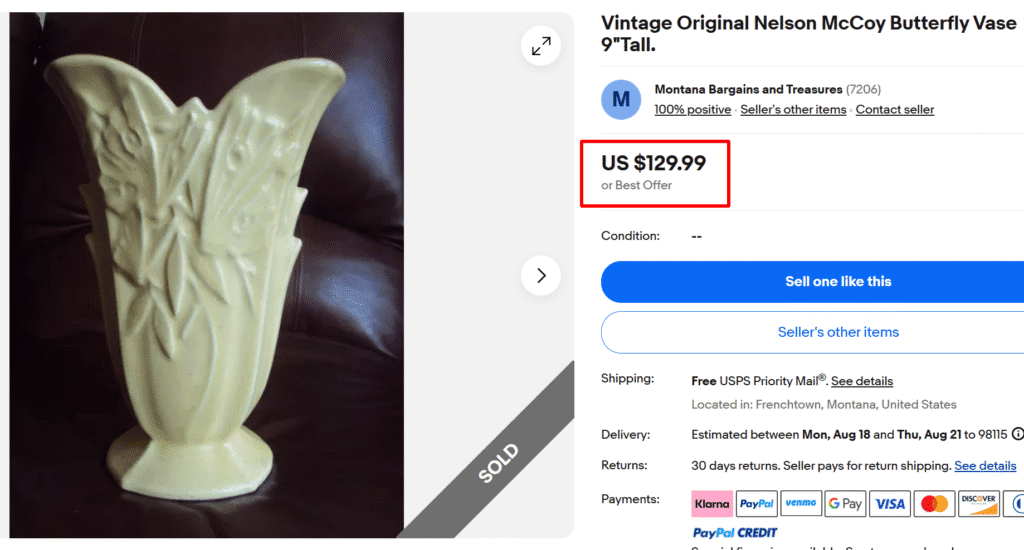
This antique 9-inch Nelson McCoy vase has a soft matte yellow glaze with embossed butterflies and branches. The Butterfly vase line was quite popular for its soft artistic touches and garden-inspired look.
This pattern was released in other shapes, like a cylindrical and castle gate, and colors pastel as periwinkle, light green, and light pink. The average value of butterfly vases ranges from $50 to $250.
7. Brush McCoy USA Blue Gladiolus Fanned Vase
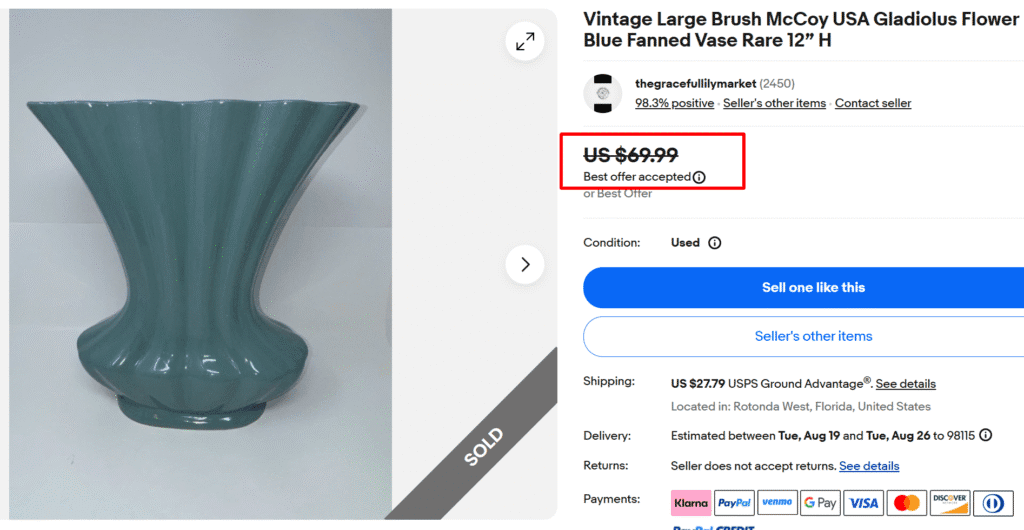
This rare 12-inch Brush McCoy vase has an elegant, wide opening like a real gladiolus flower and a cool, highly sought-after blue glaze. Made in the 1940s-50s, it’s well-built with a wide fanned rim, making it ideal for large flower arrangements. You can spot authentic pieces worth $30-$100+ by the USA marking on the bottom.
8. 1950s McCoy Pottery Chrysanthemum Vase
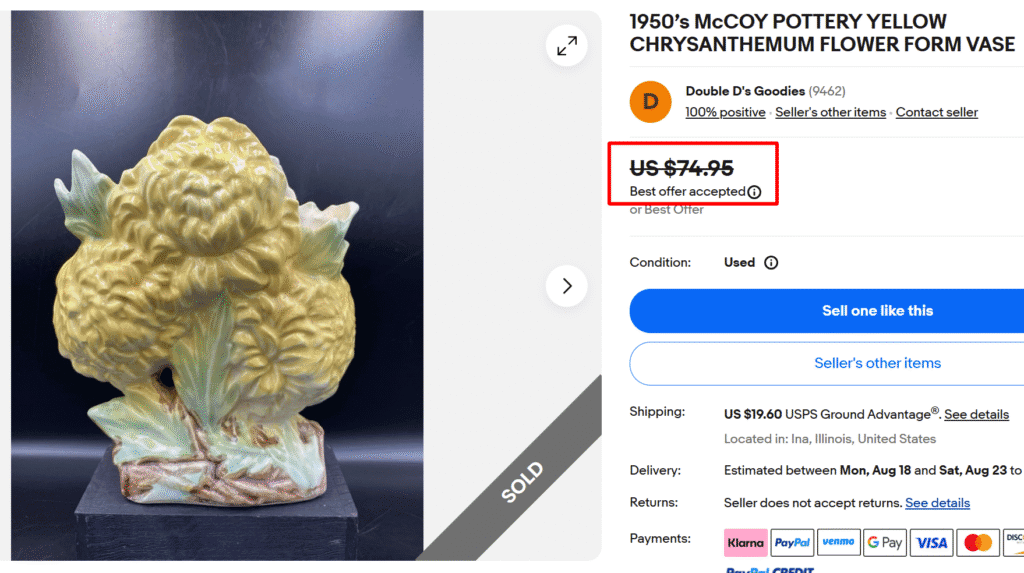
This dramatic vase from McCoy’s 1950s floral series is modeled like a real chrysanthemum flower. It shows yellow blossoms and soft green leaves over a textured base. You may also find other variations, like light purple and white.
Thanks to their lifelike hand-painted details and molding, these vases in good condition can sell for $50 to $150+, since such three-dimensional designs are popular with collectors. Also, these flower-form vases were only made for a few years and are now quite desirable.
9. 1940s McCoy Swan-Shaped Green Vase
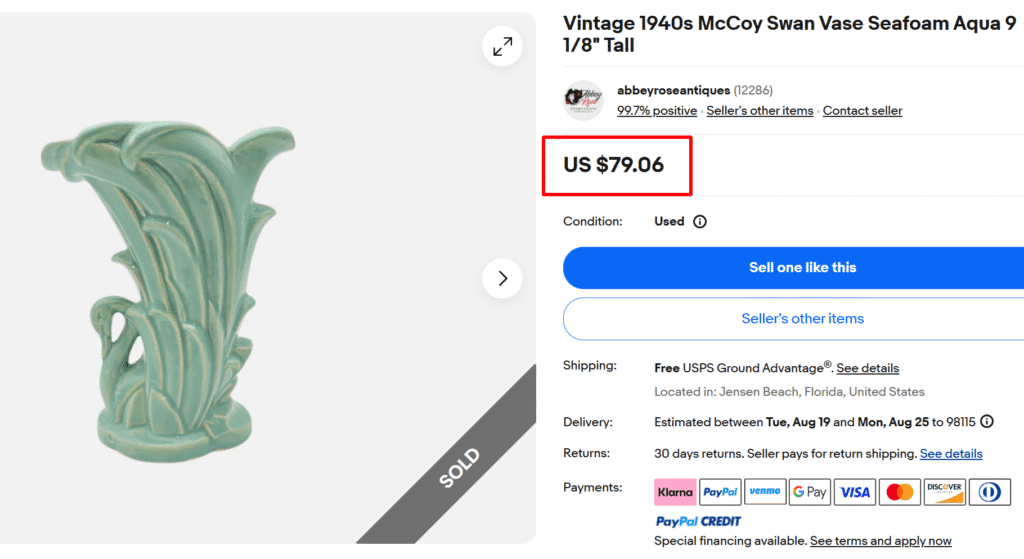
This 1940s McCoy Swan vase has an Art Deco-style design featuring a graceful swan among sweeping leaves, all in the brand’s defining beautiful seafoam aqua glaze. As one of the McCoy’s most coveted animal designs, these vases enjoy high popularity and sell for $40-$100.
10. Mailbox Wall Vase Planter
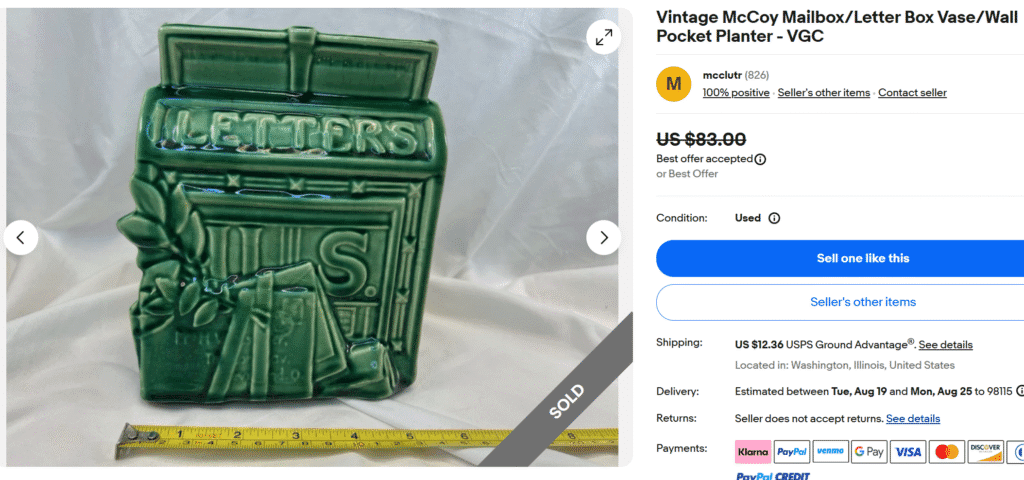
This vintage McCoy Mailbox vase is easy to spot with its embossed “LETTERS” text and leafy details, reminding one of classic American mail delivery. A part of McCoy’s fun mid-century novelty line, this vase was designed to work as a wall pocket planter, too.
The deep green glaze and sharp molding, along with its functional design, make it popular with both pottery collectors and common people.
11. McCoy 1950s Applied Ivy Vase
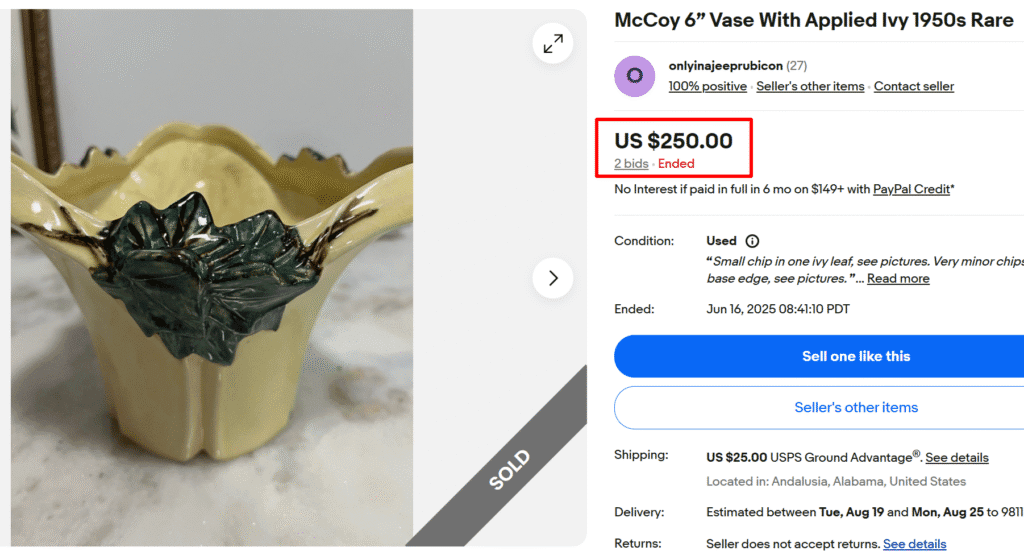
A nice example from McCoy’s popular “Ivy” series, this is a 6-inch vase from the 1950s with hand-applied green ivy leaves over a glossy yellow paneled base. It has signature glaze work and perfect molding, which McCoy was known for.
These vases were also released in other shapes and colors, like ivory or cream, but the yellow ones are the most collectible of all (sold for $250)!
12. McCoy Pottery Snowman Black Hat Planter Vase
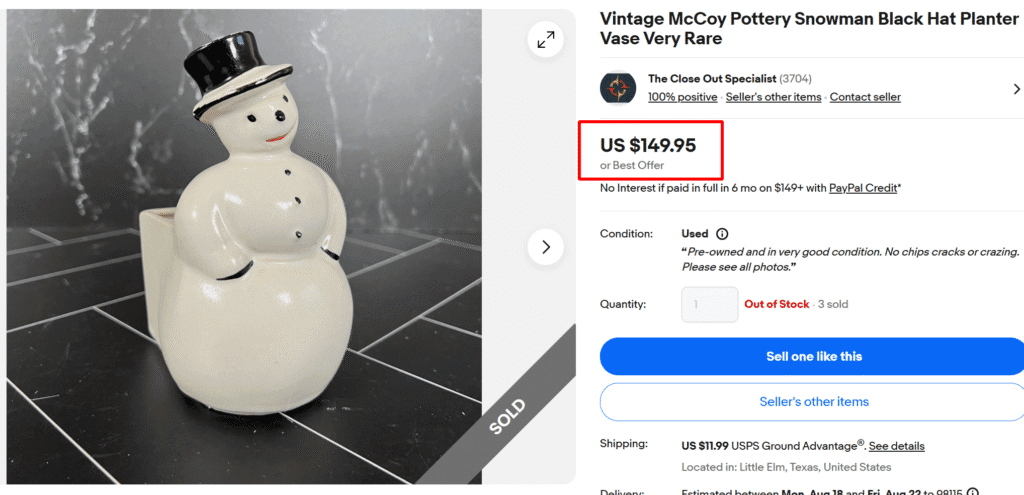
This vase/planter is shaped like a “Snowman” wearing a black top hat in classic McCoy style. You can spot it by its glossy white glaze and solid construction that shows both whimsy and quality.
Since these pieces were made as a part of seasonal lines in the mid-20th century, they are quite rare, fetching up to $150 to $250 in good condition. It proves that even smaller McCoy pieces are highly wanted by collectors!
13. Crackle Glaze Vase
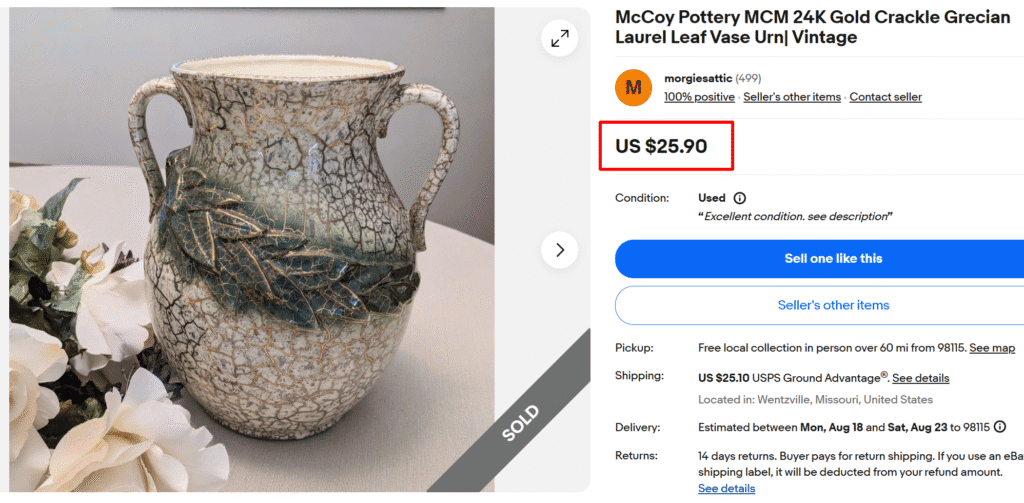
This mid-century McCoy vase has an urn shape with twin handles and crackle glaze finished with 24K gold accents. The laurel leaf relief around the body gives it a classic Greek look, mixing old-style motifs with McCoy’s 1950s-60s style.
Despite a unique glaze, these McCoy vases enjoy only moderate popularity and often sell for $20 to $70.
14. McCoy Loy Nel Art Pottery Brown Cattail Vase
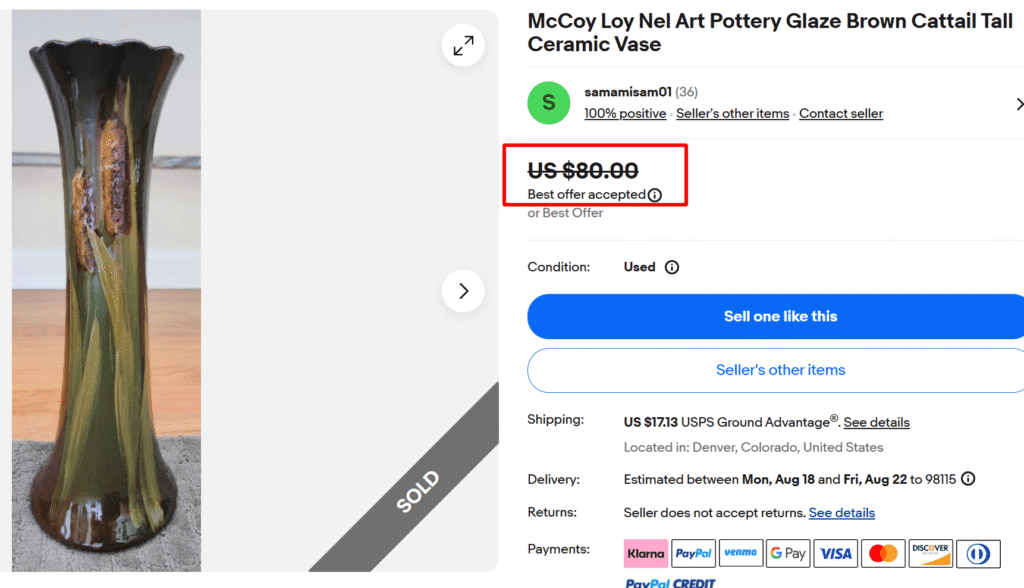
This tall McCoy Loy-Nel vase shows a unique hand-glazed blend of brown, green, and golden colors for a natural look. The raised cattail and leaf design shows why McCoy was the king of floral and nature-inspired decorative pottery.
Made during the Art Pottery period, it has a sleek shape and a good height, making it perfect for long-stemmed flowers. These vases are sold for $30 to $120, depending on condition and colors.
How to Spot Real McCoy Pottery Vases?
Identifying authentic antique McCoy vases isn’t really challenging, as the brand made sure to create its pieces with unique features, like glaze, selected colors, and markings. With detailed knowledge of these factors, you can easily spot a real McCoy pottery vase.
Base Markings
The most reliable way to identify whether or not an old vase is McCoy is the markings on the base. But this is also a tad tricky since McCoy’s markings changed constantly over the decades, and the early pieces don’t even have a mark.
The ones that have a marking, use these clues to spot and date them:
Pre-1929 Pieces:
As I told you, early McCoy pieces made before 1920 have no marks at all, making them difficult to authenticate. But there are a few other signs you can look for (which we’ll talk about later) to spot the real pieces.
Beware of “Brush-McCoy” Marks
On some pre-1929 vases, you may find the “Brush McCoy” marks. These pieces may belong to Brush-McCoy, a different company that resulted after J.W. McCoy’s original pottery merged with another company in 1911 to become Brush-McCoy Pottery Co.
And even though they sold their ownership in 1918, the name McCoy stuck around until 1925. Pieces from the Brush-McCoy period often have a mark “Brush-McCoy USA” or simply “Brush.” Even though the name “McCoy” is present, they are not really McCoy pieces.
1929-1940s Vases:
From 1929, McCoy started marking their pieces with what collectors call “shield marks.” These marks were carved (not raised) into the clay before firing. If you see these, you’re looking at a vase from this era.
- NM (for Nelson McCoy)
- NM USA
- MCP (McCoy Pottery)
- NM CO
Most of these marks were on the bottom, but you may occasionally find a blue ink stamp on the side, too.
1930s-1960s Pieces:
These McCoy pieces bear simple “McCoy” markings on the base. You might also see “McCoy USA” or “McCoy Made in USA” in some examples.
Post-1960s Pieces:
When Lancaster Colony took over McCoy, they added their initials “LCC.” So, vases from the post-1960s era will have clear “McCoy LCC” or “McCoy LCC USA” markings. Some special pieces got “24K Gold” stamps when they used real gold in the crackle glaze.
Specific Physical Features
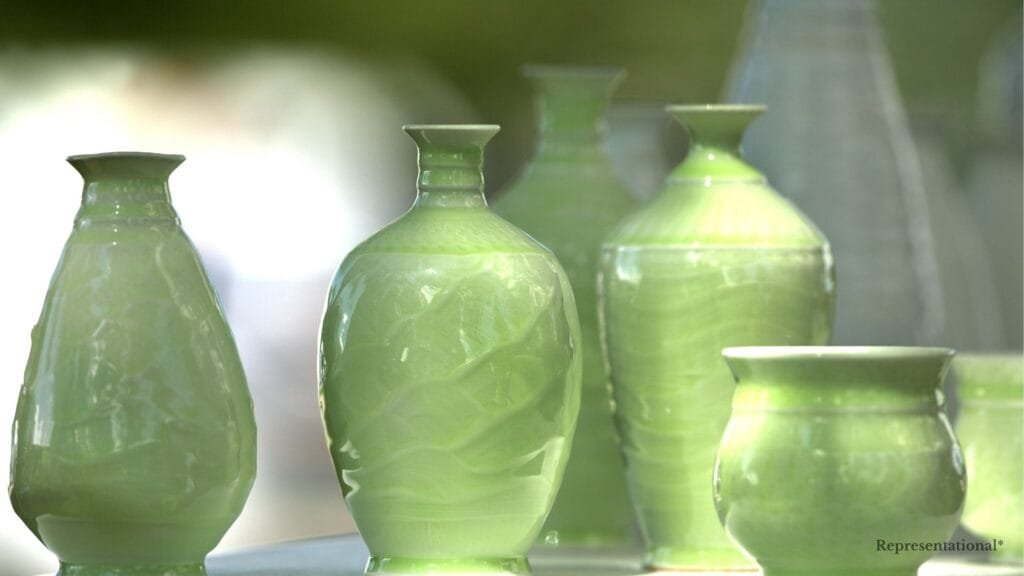
In case your vase doesn’t have a mark, you can still find out if it’s McCoy by observing its physical features, like glaze, materials, and paint style.
1. Look & Feel
Real McCoy pieces always feel substantial. If you pick up a piece and it doesn’t feel solid or is hollow or cheap, it’s a fake piece. The edges on genuine pieces are also clean, not rough or sloppy.
2. Unique Glaze
McCoy Pottery’s unique glazes and high quality are what set it apart from other pottery pieces. The most popular glazes include:
- Classic glossy glaze
- Satin matte (a velvety finish)
- Drip glazes (give a flowing, melted look; most popular)
- Crackle glazes (fine networked crazing as a decorative effect)
- Speckled glazes
- Hand-brushed colors
3. Defining Colors
The most common colors are pastel yellow, green, pink, turquoise, brown, and avocado. Many pieces have rich color blends or layered tones. Some have multi-color combinations with striking “over-drip” effects where one glaze flows over another, making each piece unique.
The following signs mean fake McCoy pottery:
- Pieces may not be in any McCoy reference book
- Size might not match documented examples
- Colors usually look too bright or artificial
- The glaze may look wrong for the period
For more information, refer to some McCoy reference books to check what authentic pieces really look like!
4. Shapes & Designs
McCoy pottery comes in many different shapes, from the usual vases and planters to fun animal and character designs. The most common decorative patterns you’ll see are berries, leaves, butterflies, birds, and fruit.
These are usually done in relief (raised up from the surface) or molded right into the piece. McCoy really liked nature themes, so most of their decorative work features plants or animals in some way.
As for shapes, you’ll find everything from basic cylindrical flower pots to pieces shaped like swans, dogs, or even mailboxes. This variety is why McCoy pottery appeals to so many collectors.
Another important thing to notice is that original McCoy pieces have good symmetry, balance, and proportions that look right.
Size Consistency
Another important sign to check for authenticity is the size. Real McCoy pieces were made using consistent molds, so the size and shape should match what you see in old catalogs or reference books. And the size of all pieces from the same line (same mold) should be the same.
If you come across pieces that look like McCoy but seem a bit smaller, 6% or smaller, they’re probably reproductions. This happens because those pieces are made with a reproduced mold using an original piece, reducing its size.
What Makes Vintage McCoy Vases Valuable?
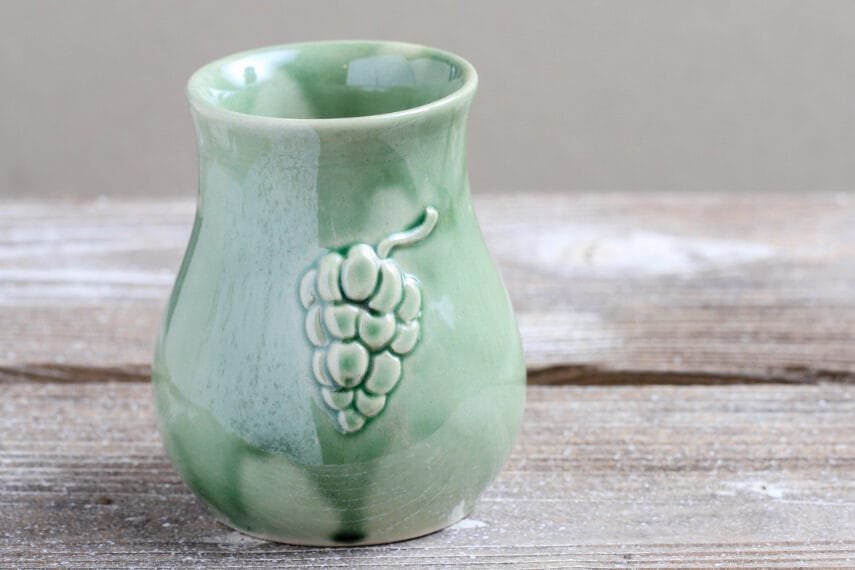
Even though it is authentic, not every McCoy vase will be worth hundreds or thousands. That’s because the actual worth doesn’t just depend on whether it is authentic or not, but it also relies on several other factors. Let’s understand:
It Should Be Authentic
Needless to say, vases that don’t identify or authenticate as McCoy won’t be worth much. So, look for the markings, pay attention to the obvious distinctive features, and check documented examples.
Also, genuine vintage pieces will show certain signs of aging, like fine crazing, soft patina (surface sheen), dullness, subtle color variations or staining, thinning, and base wear. Too perfect pieces? Likely a fake!
Is It Rare?
The answer to this is what decides whether an old McCoy vase will be worth $5 or $500. Why? Because some McCoy pieces are just harder to find for different reasons, making them highly sought-after. Here’s what makes these vases rare:
- Limited Runs: McCoy made some lines for a limited time or in limited numbers. Vases from these special edition lines are rather rare. Early hand-painted Loy-Nel-Art pieces and Sidney Cope designs are perfect examples.
- Test Pieces: Prototype pieces or experimental pieces made to test certain color, shape, size, or glaze that weren’t mass-produced can be super valuable.
- Unique Colors: McCoy pieces featuring colors that weren’t in their regular line, like deep cobalt blue or a certain shade of turquoise, can fetch hundreds. Distinctive glazes are rare, too!
- Size Matters: Unusually large or small pieces within a pattern are often considered rare and worth more. A 4-inch vase from a line that had only 6-inch pieces is SPECIAL!
Is It In Good Shape?
Rarity drives value, but even the rarest of McCoy pottery vases may lose over 50% of its value if it is in poor condition. So, make sure to check for the following damages (they can hurt the worth):
- Serious chips and cracks
- Faded paint or discoloration
- Heavy or discolored crazing
- Faulty or irregular glaze
- Amateur restoration or visible repairs
In a nutshell, minor damage or wear is a sign of age, but significant damage is a red flag!
Is It a Documented Piece?
Documentation that tells the background story of a McCoy vase, like old catalog pages, advertisements, or real photos, not only authenticates the piece but also impacts its value. Collectors pay more for items with clear connections to their origins.
So, make sure to look for the following items:
- Original receipts or invoices
- Auction house or gallery records
- Old McCoy catalog pages (show the original model, color, and design details)
- Historical photographs (pictures of the piece in use, especially with dates)
- Authentication certificates, if verified (third-party verification from recognized pottery or experts)
- Repair records (details of any restoration or repair work with dates & methods)
Note: This article is intended for informational, educational, and entertainment purposes only. Some images are illustrative and may not represent actual brands, products, or related entities. All trademarks, product names, brand logos, packaging, and other intellectual property referenced remain the exclusive property of their respective owners. Any brand mentions or references are provided solely for descriptive and educational context and do not imply any formal or commercial association.

